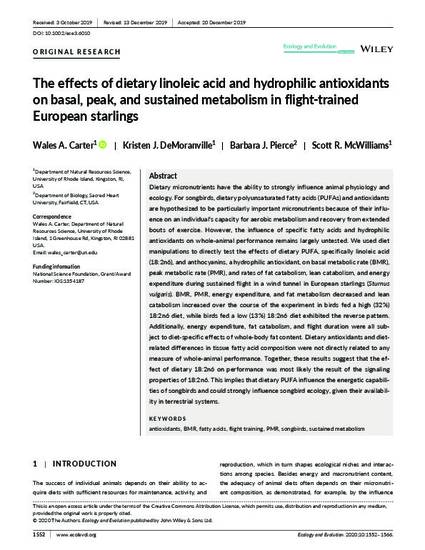
Dietary micronutrients have the ability to strongly influence animal physiology and ecology. For songbirds, dietary polyunsaturated fatty acids (PUFAs) and antioxidants are hypothesized to be particularly important micronutrients because of their influence on an individual's capacity for aerobic metabolism and recovery from extended bouts of exercise. However, the influence of specific fatty acids and hydrophilic antioxidants on whole‐animal performance remains largely untested. We used diet manipulations to directly test the effects of dietary PUFA, specifically linoleic acid (18:2n6), and anthocyanins, a hydrophilic antioxidant, on basal metabolic rate (BMR), peak metabolic rate (PMR), and rates of fat catabolism, lean catabolism, and energy expenditure during sustained flight in a wind tunnel in European starlings (Sturnus vulgaris). BMR, PMR, energy expenditure, and fat metabolism decreased and lean catabolism increased over the course of the experiment in birds fed a high (32%) 18:2n6 diet, while birds fed a low (13%) 18:2n6 diet exhibited the reverse pattern. Additionally, energy expenditure, fat catabolism, and flight duration were all subject to diet‐specific effects of whole‐body fat content. Dietary antioxidants and diet‐related differences in tissue fatty acid composition were not directly related to any measure of whole‐animal performance. Together, these results suggest that the effect of dietary 18:2n6 on performance was most likely the result of the signaling properties of 18:2n6. This implies that dietary PUFA influence the energetic capabilities of songbirds and could strongly influence songbird ecology, given their availability in terrestrial systems.
Carter, W. A., DeMoranville, K. J., Pierce, B. J., & McWilliams, S. R. (2020). The effects of dietary linoleic acid and hydrophilic antioxidants on basal, peak, and sustained metabolism in flight‐trained European starlings. Ecology and Evolution, 10(3), 1552-1566. Doi: 10.1002/ece3.6010

This is an open access article under the terms of the Creative Commons Attribution License.